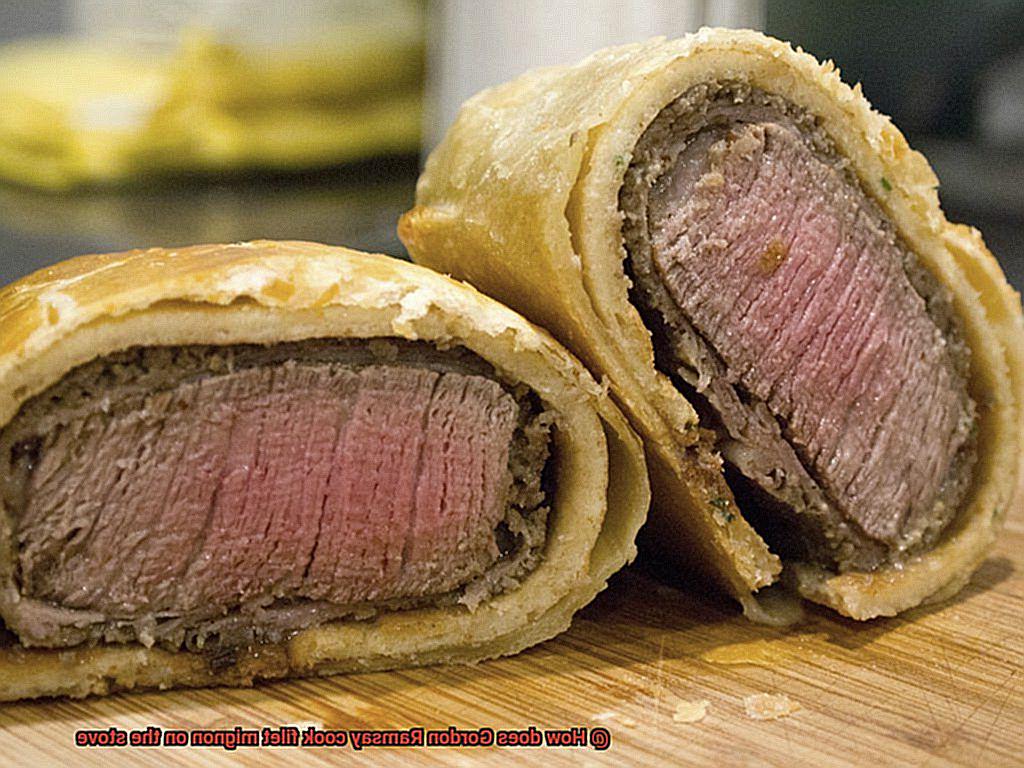Do you salivate at the thought of a perfectly cooked steak? Are you curious about how Gordon Ramsay, the culinary mastermind, cooks filet mignon on the stove? Then buckle up and get ready to learn from the best.
Gordon Ramsay’s reputation precedes him as a celebrity chef and restaurateur with an unparalleled passion for cooking. His signature dish, filet mignon, is no exception. In this blog post, we’ll delve into his unique cooking method that sets his filet mignon apart from the rest.
What makes Gordon Ramsay’s technique so special? It all starts with a cast-iron skillet heated to high temperatures that sear the steak and trap its succulent juices. He adds rosemary and thyme to infuse the steak with an explosion of flavors and aromas that will leave your taste buds begging for more.
But wait, there’s more. Gordon Ramsay has additional tricks up his sleeve when it comes to cooking filet mignon on the stove. The “touch test” technique allows him to determine doneness without cutting into the steak, ensuring it remains juicy and tender. He also stresses the importance of resting before serving to allow those delicious juices to redistribute throughout the meat.
Whether you’re a seasoned steak enthusiast or just starting out in your culinary journey, Gordon Ramsay’s recipe for filet mignon is sure to impress even your toughest critics. So fire up that stove and get ready for a mouth-watering experience like no other.
Contents
What You Need to Cook Filet Mignon
To start, you’ll need to gather some essential ingredients and tools in order to cook this delectable steak to perfection.
First and foremost, select a high-quality cut of filet mignon, at least 1 ½ inches thick, with good marbling throughout. This tender, juicy cut is known for its buttery texture and rich flavor, making it a favorite among steak lovers.
Next, equip yourself with some basic kitchen tools. A cast-iron skillet is perfect for stove-top cooking, as it retains heat evenly and allows for consistent cooking. You’ll also need tongs to flip the steak, a meat thermometer to ensure your preferred level of doneness, and some butter or oil for searing and basting.

It’s important to let your steak come to room temperature before cooking. Remove it from the refrigerator at least 30 minutes beforehand to allow it to warm up. This will ensure even cooking throughout the steak.
Before searing your filet mignon, season both sides generously with salt and pepper. This simple step will enhance the natural flavors of the meat.
Now it’s time to heat up that cast-iron skillet on high until it’s smoking hot. Add a little bit of oil and place the filet mignon in the skillet, laying it away from you to avoid any hot oil splatters. Cook the steak for about 2-3 minutes on each side, using tongs to flip it. Be careful not to use a fork which could puncture the meat and cause it to dry out. While cooking, baste the steak with butter and herbs to add extra flavor and moisture.
Once cooked to your liking, remove the steak from the skillet and let it rest for a few minutes before slicing and serving. This crucial step allows the juices to redistribute throughout the meat and ensures a juicy and tender steak.
Prepping the Filet Mignon
Then, it’s time to learn how to prep filet mignon like a pro. By following Gordon Ramsay’s techniques, you’ll be able to achieve a dish that’s both flavorful and delicious.
To start off, make sure your filet mignon sits at room temperature for around 30 minutes before cooking. This ensures even cooking throughout. While waiting, generously season both sides with salt and pepper to bring out its natural flavors.
Next, grab a cast-iron skillet and add just enough oil to coat the bottom of the pan. This helps prevent the steak from sticking during cooking. Heat the skillet until it’s hot and then place your seasoned filet mignon in the pan. Don’t forget to press down gently to ensure contact with the skillet.
Cook each side of the steak for about 2-3 minutes on high heat until a mouth-watering golden brown crust forms. Remember to flip the steak only once during cooking to guarantee an even doneness.
Once cooked to your liking, let the filet rest for a few minutes before slicing and serving. This allows the juices to redistribute, resulting in a tender and flavorful piece of meat.
In summary, by prepping your filet mignon properly and using high heat for a short amount of time, you’ll achieve a perfect sear and juicy interior that will have your taste buds dancing with delight. Trust us, your guests will be raving about this dish long after they’ve left your table.
Cooking the Filet Mignon on a Cast Iron Skillet
Filet mignon is a cut of steak that is loved by people all over the world. However, the secret to cooking it perfectly lies in the method used. Fear not, because we have got you covered. In this article, we will teach you how to cook filet mignon on a cast iron skillet like a pro.
The first step is to let the meat come to room temperature before cooking. This usually takes around 30 minutes and ensures that the steak cooks evenly throughout. Once this is done, preheat your cast iron skillet on high heat for about 5 minutes. Cast iron skillets are perfect for searing meat as they offer even heat distribution.
As the skillet heats up, generously season your filet mignon with salt and pepper on both sides. Once the skillet is hot enough, add some oil and wait until it starts smoking. Then, add your seasoned steak and let it cook for about 2-3 minutes on each side. Avoid flipping it too often as this can cause the steak to lose its juices.
To achieve a perfect sear on the steak, baste it with melted butter and some crushed garlic using a spoon or tongs once you flip it over. This adds flavor and helps keep the steak moist.
Once you have achieved your desired level of doneness, remove the filet mignon from the skillet and let it rest on a plate for about 5 minutes. This allows the juices to redistribute throughout the meat resulting in a tender and juicy steak.
In summary, cooking filet mignon on a cast iron skillet is an easy yet effective method used by chefs worldwide. Here are some tips to remember:
- Let your meat come to room temperature.
- Preheat your cast iron skillet.
- Season your steak well.
- Baste it with butter for extra flavor.
- Allow it to rest for 5 minutes before slicing into it.
Seasoning the Steak for Maximum Flavor
The secret to maximum flavor lies in the seasoning. And who better to turn to for advice than the world-renowned chef, Gordon Ramsay?
To begin, ensure that your steak is free of any moisture by patting it dry with paper towels. This step is critical as any excess moisture can prevent the steak from forming a delicious crust when cooked. Once dry, season generously with coarse sea salt and freshly ground black pepper on both sides, ensuring that the seasoning is evenly distributed for a burst of flavor in every bite.
But why stop there? To elevate the flavors even further, Ramsay suggests adding chopped garlic and thyme to the pan while cooking. The aroma of these ingredients will infuse into the steak, resulting in a tantalizing explosion of flavors.
As the steak approaches its final stages of cooking, basting it with butter will give it a rich and savory taste. However, be mindful not to over-season as too much seasoning can overpower the natural flavors of the meat.
In conclusion, seasoning is key to maximizing the flavor of your steak. Follow Gordon Ramsay’s expert techniques for seasoning and you’ll be sure to impress not only yourself but anyone you’re cooking for. To recap:
- Pat your steak dry with paper towels before seasoning
- Season generously with coarse sea salt and freshly ground black pepper
- Add chopped garlic and thyme for an extra kick
- Baste with butter towards the end of cooking
- Use just enough seasoning to enhance the taste without masking it.
Basting the Steak with Butter and Herbs
Look no further than basting your steak with butter and herbs. This classic technique is a go-to for many chefs, including the renowned Gordon Ramsay.
To start, select a high-quality filet mignon that’s at least an inch thick. This ensures even cooking and maximum juiciness. Heat up a large skillet over high heat until it’s very hot. Add a tablespoon of vegetable oil and swirl it around the pan. Place the steak in the skillet and let it sear for 2-3 minutes on each side without touching it. This creates a delicious crust on the outside while keeping the inside juicy.
Once you’ve flipped your steak, add a few tablespoons of butter, some garlic cloves, and a few sprigs of fresh thyme or rosemary to the pan. As the butter melts, use a spoon to baste the steak with the butter and herbs. This infuses it with flavor and keeps it moist as it cooks.
Continue cooking for another 2-3 minutes, basting frequently with the melted butter and herbs. Check the temperature with an instant-read thermometer – it should be around 130°F for medium-rare.
When your steak is cooked to perfection, remove it from the skillet and let it rest for a few minutes before slicing into it. This allows the juices to redistribute throughout the meat, resulting in an even more tender and flavorful steak.
Here are some additional tips to take your basted steak to the next level:
- Experiment with different herbs and spices to create unique flavor profiles.
- Use clarified butter instead of regular butter for a richer flavor.
- For an extra decadent twist, add some blue cheese crumbles on top of your basted steak before serving.
Flipping the Steak with Tongs
Look no further than mastering the art of flipping the steak with tongs. As a seasoned expert in this field, let me guide you through this essential technique with my researched tips.
Let’s start by discussing the importance of using tongs over other cooking utensils. Gordon Ramsay himself recommends tongs as they’re less likely to pierce the meat, keeping all those delicious juices locked in. Plus, their sturdy grip makes it easier to flip the steak without it falling apart.
Now, let’s dive into the actual technique. The key is to wait until a crust has formed on one side of the steak before flipping. This ensures that it remains intact and doesn’t break apart on you. When ready, use your trusty tongs to gently lift and flip the steak over, but be cautious not to splash any hot oil or butter onto yourself.
Once flipped, it’s time to give it a gentle press down with your tongs. This helps distribute heat evenly and create that perfect crust on both sides. However, beware of over-flipping. Flipping too often can lead to uneven cooking and overcooking, which ultimately ruins your dish. So, heed Gordon Ramsay’s advice and flip only once, roughly halfway through the cooking process or when your desired level of doneness is almost achieved.
Letting the Steak Rest After Cooking
If you want to savor the perfect filet mignon, there’s one critical step you cannot overlook – letting it rest after cooking. Yes, the temptation to dive right into that juicy piece of meat is real, but hold off for just a few minutes and you’ll be rewarded with an even more mouthwatering steak.
Why is letting your steak rest so important? Well, during the cooking process, the heat causes the juices in the steak to move towards the center. If you cut into it immediately after cooking, those juices will spill out onto your plate, leaving you with a dry and tasteless piece of meat. But, if you let your steak rest for at least 5 minutes, those juices have time to redistribute throughout the meat, resulting in a more flavorful and tender steak.
And let’s talk about flavor for a minute. Allowing your steak to rest gives it time to fully absorb all those delicious flavors from the cooking process. It’s like giving a fine wine time to breathe before taking a sip – it just enhances the overall experience.
So how do you let your steak rest properly? Easy – remove it from the pan or grill and place it on a cutting board. Cover it loosely with foil to keep it warm and let it sit for at least 5 minutes while you prepare any sides or sauces to accompany your steak.
But wait, there’s more. Slicing your steak correctly also plays a crucial role in achieving that perfect bite. Gordon Ramsay recommends slicing against the grain, which means cutting perpendicular to the direction of the muscle fibers. This results in a more tender cut of meat that practically melts in your mouth.
Slicing and Serving the Perfectly Cooked Filet Mignon
You’ve cooked the perfect filet mignon – a masterpiece of tender, juicy, and flavorful meat. But wait, before you indulge in this culinary delight, let’s talk about the art of slicing and serving this delicious dish.
Firstly, we cannot emphasize enough the importance of letting your filet mignon rest before slicing. With just 5-10 minutes of patience, the juices will redistribute throughout the meat, resulting in a more succulent and flavorful bite.
Once rested, it’s time to slice. A sharp knife is an essential tool here, as it allows you to cut through the meat without tearing it apart. Beginning against the grain, slice your filet mignon into 1/2 inch thick pieces. This will ensure tenderness and ease of chewing with each bite.
Presentation is key when it comes to serving your filet mignon. Whether you choose to serve it whole or sliced on a plate, pairing it with simple sides such as roasted vegetables or mashed potatoes will allow the flavor of the meat to shine through. To elevate your dish even further, add a delicious sauce such as red wine sauce, mushroom sauce, or garlic butter sauce.
It’s important to remember that filet mignon is a high-quality cut of meat that deserves proper treatment. So take your time, savor each bite, and relish in your culinary achievement. Who knows? Maybe one day you’ll be known as the filet mignon expert among your friends and family.
AJGSFpa0AlY” >
Conclusion
To cook the perfect filet mignon on the stove, one must approach it like an art form. It requires patience, attention to detail, and a few expert techniques that only a culinary master like Gordon Ramsay can teach.
Ramsay’s unique cooking method begins with prepping your steak with the right seasoning and using a cast-iron skillet to achieve that perfect sear. But what sets his filet mignon apart from the rest is his basting technique with butter and herbs, which infuses the steak with flavor and keeps it juicy.
And let’s not forget about the “touch test” technique that Ramsay uses to determine doneness without cutting into the steak. This ensures that your filet mignon remains tender and succulent.
But perhaps one of the most important steps in cooking filet mignon is letting it rest before slicing and serving. This allows for all those delicious juices to redistribute throughout the meat, resulting in a mouth-watering experience that will impress even your toughest critics.
So fire up that stove and follow these tips and tricks from Ramsay himself. With practice, you too can become a filet mignon pro in no time.






